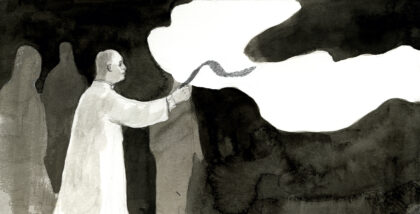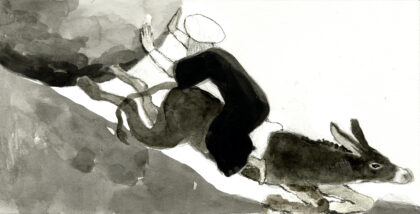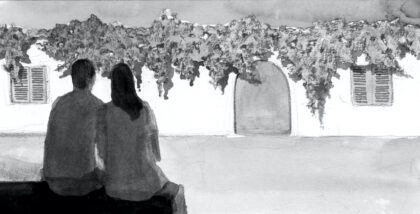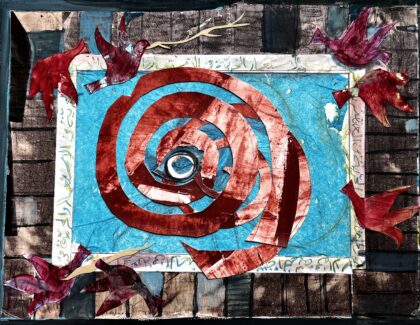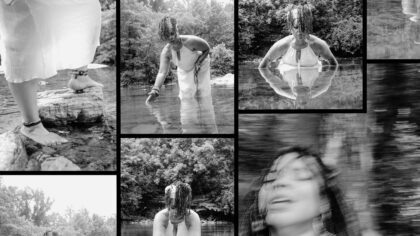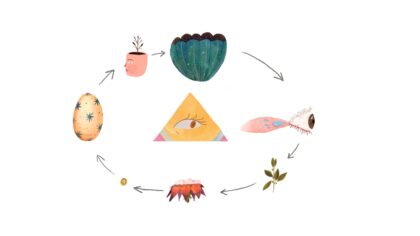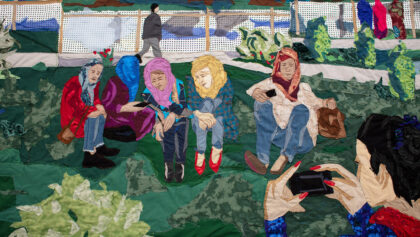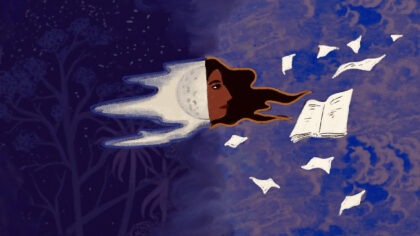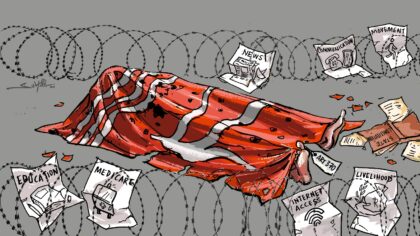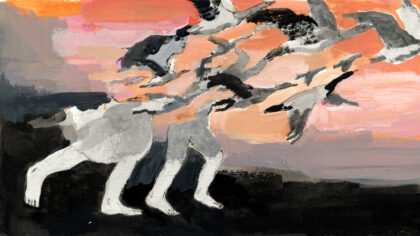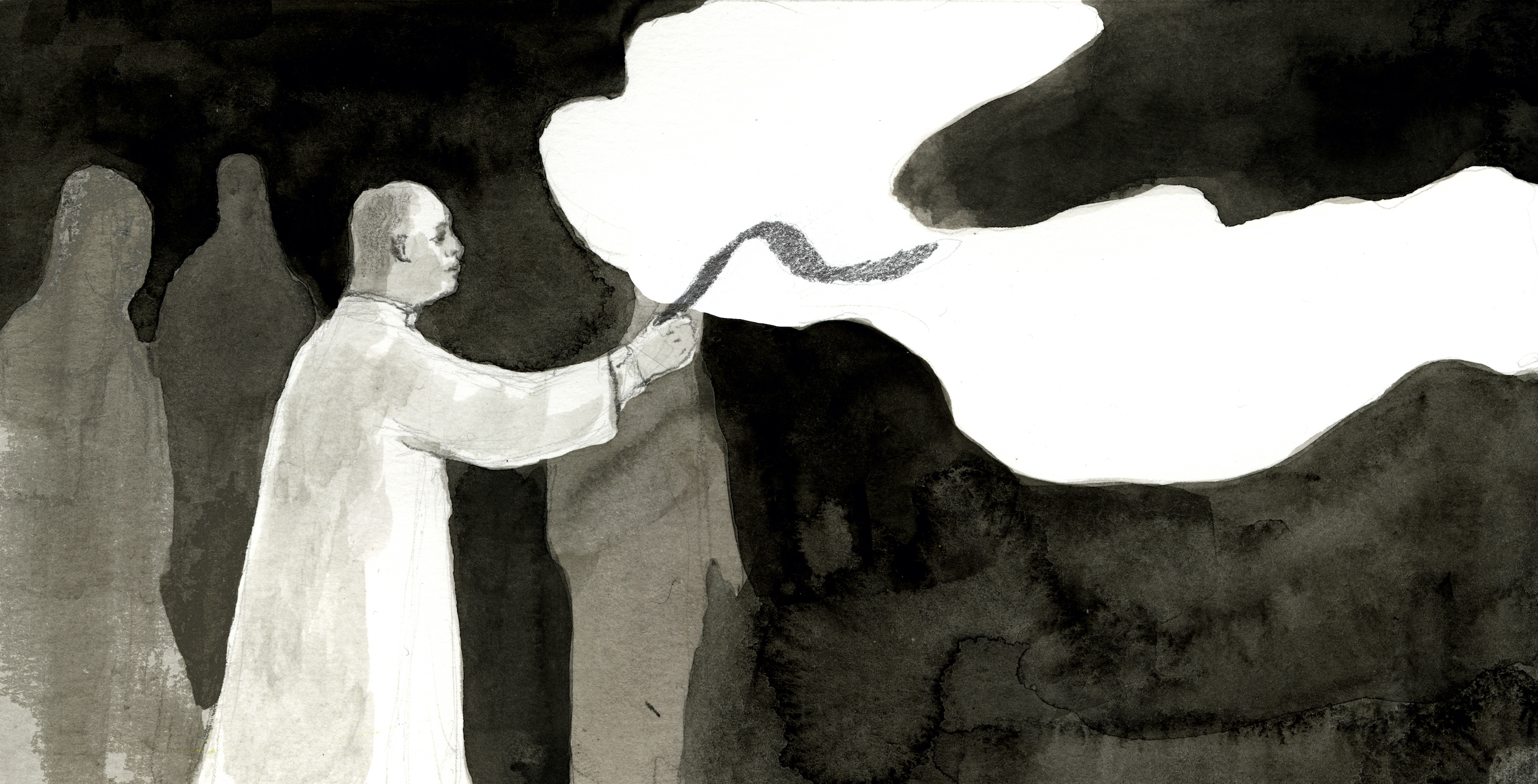 Art by Jia Sung
Art by Jia Sung
Nairobi is a city whose geography reveals its history. In road names, in the presence or absence of trees, in altitude and drainage and architectural styles. The British colonial heritage of the YWCA, for example, is unmistakable. Though small and somewhat modest, the hostel and conference center complex is set in the Tudor style, with its distinct timber façade. Even more unmistakably colonial is its location: on a hill just west of Uhuru Highway, the thoroughfare that bifurcates Nairobi informally into “uptown” and “downtown.” The YWCA is on the uptown side, overlooking the greenery of Uhuru Park on Mamlaka Road. Mamlaka means “authority” or “dominion” in Kiswahili; that road leads up to the State House, which was the governor’s mansion during colonial times. The center is a mere 200 meters down the road from Nairobi Primary School, exclusively used for white children during Kenya’s segregated colonial era, which officially ended in 1963 with Kenya’s independence.
Perhaps it was fate, or serendipity, that the YWCA, this place literally constructed of British colonialism, was the venue for the Whiteness Conference, organized in 2018 and 2019 by a small group of students, activists, writers, academics, and uncredentialed Kenyans. We were on a journey to demystify and deconstruct whiteness in a country that on paper is an independent Black nation but which, in practice, continues to uphold whiteness as the standard for all that is good, true, and valuable. In Kenya, whiteness remains an organizing philosophy, an epistemological tool, and a way of being in the world, normalized so thoroughly as not to need white bodies to enact it; Black bodies do the work just as effectively. But in a matter of months after the second edition of the conference, that small organizing group would begin to fragment, relationships would splinter, and friends would drift apart, scattered not by overt infiltration or sabotage, which the FBI used against so many Black freedom dreamers in the US, but instead by internal breakdown, a quiet collapse that was perhaps a testament to the weight of what was at stake.
*
I grew up in middle-class Nairobi, where meritocracy is championed and the injustice of its underside downplayed or ignored. This is a kind of conditioning that prepares middle-class Kenyans to integrate seamlessly into structures of oppression—to accept salaries that are a fraction of their Western expatriate colleagues who perform the same role, to uncritically assume that white research methods are the only way to know things, to never think about why the wealthiest neighborhoods in the city are almost always right next to the poorest. To grow up in Nairobi is to read Gifted Hands and Think Big by Ben Carson, to tithe to the prosperity gospel, to play passive witness to white saviorism performed in the name of missionary work. It is to be prepared for a life of acquiescence and vigorous support of a racist status quo. It is to be ready to become a Priti Patel, a Clarence Thomas, a Candace Owens.
In mid-2017, I moved from Nairobi to Cambridge, Massachusetts, where I spent an academic year as a fellow at the Nieman Foundation for Journalism at Harvard University. If there is one recurring theme in contemporary African diaspora literature, it is the transformative experience of being away from home, of how that dislocation makes Africans—especially those coming from Black-majority countries like my own—hyper aware of their Blackness, perhaps even of racism, for the first time. I find this framing problematic; it is like hearing men say that it wasn’t until they had a daughter that they discovered women are humans, too. Still, my year away did impact me significantly, primarily revealing to me how underdeveloped my vocabulary and analytical precision was in recognizing, naming, and critiquing whiteness.
This relative lack of language wasn’t fully apparent to me until my year away, and it was a jarring experience for me as a writer. It is, perhaps, the result of living in a country that gained “independence” six decades ago, but whose ruling comprador class has always firmly cast its lot with Western interests. Kenya is frequently described as a “geopolitically strategic” nation in East Africa, language that both assumes and coerces its support for the West in the international arena. For example, Kenya declined to support South African freedom fighters during the apartheid era, while our southern neighbor, Tanzania, offered sanctuary. Today, the “aspirational” neighborhoods of Nairobi—full of expats and the upper-class Kenyans who control the country’s politics and economy—feel like a small Western city, with expat-friendly coffee shops, big malls with name-brand stores, and bikram yoga. There are wine and cheese festivals, occasionally atop picnic blankets, if that’s your thing.
I began to see more clearly the problem with living in a country whose oppressive class looks the same as you, who boasts the same genealogies and invokes slogans you, too, want to believe, such as “independence” and “development.”
In wintry Cambridge, as I was wrestling with Du Bois and Baldwin, Hansberry and Morrison, Thurman and King, I began to see more clearly the problem with living in a country whose oppressive class looks the same as you, who boasts the same genealogies and invokes slogans you, too, want to believe, such as “independence” and “development.” This form of oppression is so familiar that it feels low grade, and yet it is relentless, repetitive, and diffuse, robbing one of language and definitional clarity. It is the way abuse at home remains invisible, so often and for so long, even to the victim. During my year away, the pervasive imperial system of white supremacy became clearer to me, a system that makes it so easy, as Du Bois wrote, “by emphasis and omission, to make children believe that every great soul the world ever saw was a white man’s soul; that every great thought the world ever knew was a white man’s thought; that every great deed the world ever did was a white man’s deed; that every great dream the world ever sang was a white man’s dream.”
*
In 2018, a few months after I returned home, I was introduced by a mutual friend to Pastor Curtis Reed, the de facto leader of the group that organized the Whiteness Conference. I say de facto because he would resist being described as the head of anything; the group was, in principle if not fully in practice, anti-hierarchical. An African-American from Chicago’s South Side, Curtis had first come to Kenya in 1999, on a mission to attend seminary on the continent. He wanted to study among African Christians, hoping, like so many African-Americans do, that “if a more just society is to be found, then it surely must be here in Africa, the place of our origin.”
Alas.
Curtis had been living in Kenya for about 13 years, pastoring and mentoring young people, when, in 2017, he began teaching a class called “Hip Hop and the Bible” at Daystar University, a Christian institution with links to white American evangelicals. In that course, he and his students explored similarities between the ancient Jewish prophetic tradition and hip hop’s articulation of the ills of unjust society. That semester—by coincidence—there was a hip hop conference at Emmanuel Baptist Church, in Nairobi, and Curtis and some of his students decided to attend.
“It was horrible,” Curtis remembers. “This one Kenyan pastor was particularly aggressive in denigrating Kenyan gospel hip hop as a genre. His entire session was about how local music was shallow and repetitive, and he juxtaposed it with European hymns for their supposed theological depth.” The conference tore into Kenyan music generally as simple, and thus immature, underdeveloped, even “irritating.”
This was whiteness at work, Curtis thought, an aesthetic which values linearity over circularity. What was termed “shallow,” Curtis saw as an African style of expression of call-and-response, of repeating a simple song “until it begins to swell up in value.”
Curtis was distressed that many of the hip hop artists in attendance were buying it. Even more jarring, the pastor was Kenyan. If he had been a white pastor, perhaps the whiteness at work in this point of view would have been more self-evident. “Because we have no way of naming it specifically,” Curtis said, “it was taken as unequivocally factual that European hymns are, in fact, the only music that is aesthetically pleasing and theologically meaningful.”
Curtis and his students went to the conference expecting to find something life affirming, but they left feeling disturbed and deeply grieved. So, some of the students began a year-long journey, on their own time, to examine whiteness as an ideology and an organizing principle in the world. It was an attempt to learn the contours of whiteness, as the hip-hop conference had painfully shown, and to reject its claims to universalism and superiority. It was a way of figuring out how to exist with wholeness in a world that insists, as I had heard Cornel West say at Harvard, that “Black history is a curse, Black love is a crime, Black freedom is a pipe dream and Black hope is a joke.”
The meetings were heavy. Curtis remembers lots of tears. “They were tears of relief, that finally someone has said something that explains why my life is in a mess,” he said, and “tears of rage, that I’ve been imprisoned for so long [by] thinking that this was the only way the world could be.”
Karwitha Kirimi, one of the students in that group, remembers that pain as a kind of recognition. “It was really affirming to be able to name these things that had structured our lives and that were so violent to our humanity for so long,” she told me. “Especially naming them in Nairobi. Existing in this city is like being a fish in water and you can’t perceive the water. The water in Nairobi is whiteness.”
*
I joined the group a few months after it had begun. By then, its members had decided to expand the conversation and hopefully catalyze something bigger in Nairobi, and they were planning a two-day conference to demystify and deconstruct whiteness.
The Whiteness Conference itself was, as far as I am aware, the first in Nairobi to critically examine whiteness as an epistemology, a philosophy, and a way of being. There was a session on how whiteness manifests in the Kenyan education system, which has ostensibly “Africanized” the curriculum by adding African authors but still asks children to list the “advantages and disadvantages of colonialism.” Another looked at whiteness in economics, unpacking the twinning of capitalism and racism—that Western industrialized nations were only able to amass wealth and “develop” because they pillaged the lands they had colonized. I led a session on whiteness in Christianity, sharing my faith journey to Black liberation theology and other lessons from my year away from home and afterward, as I remained in community and in study groups with Black radical Christians in the US.
I have to lean on my church roots to describe the mood in the room over those two crucial days. There was, as we would say during Pentecostal revival meetings in my younger years, “a shift in the atmosphere.” Just like Curtis told me had happened in the meetings of the organizing committee in the year prior, there was shock, rage, relief, surprise. We could finally put into words why everything in our world seemed rigged against Black thriving, why our grandmothers had to throw away or burn their clothing, pots, and pans in order to call themselves Christians, why Kenyan coffee farmers are paid cents for their beans as multinational coffee chains sell six-dollar lattes.
About 100 people came to our conference, but attendance wasn’t really our metric of success. We sought something more existential. Curtis remembers it now as “one of the most beautiful experiences I’ve even been a part of.”
He said: “I was stunned and challenged, and moved to be with people who were working to become more human and were able to identify whiteness as an impediment to their humanity. I’m not exaggerating when I say it was the closest to the kingdom of God that I’ve experienced.”
*
But the high was short-lived. We knew that we needed to give ourselves and the conference attendees space to process and debrief. So, a couple of months after the conference, we invited folks for a picnic at Nairobi Arboretum, one of the few well-maintained public green spaces in a city where parks and playgrounds have long been privatized or left to decay. It was a beautiful, sunny Sunday morning, with just enough breeze to temper the January heat and make you want to be outside the whole day.
There, as the sun shone through the trees, conference attendees described how heart-rending the conference had been, in putting into words the psychic assaults of being Black in this world, in this city. There was relief, but there was also rage and a sense of disorientation that has not abated since the conference, since seeing the sharp outlines of whiteness with disturbing clarity. I remember listening to one woman describe how lost and sad she felt realizing that all her striving for excellence was part of a bigger, much bleaker story. We spoke in fragments, hesitatingly, about the profound sense of grief, fear, and smallness that we were all grappling with. But no one was really brave enough to say aloud The Thought we had all contended with since: it was better when I didn’t know; it would have been better if I had never started down this path.
Curtis’s melancholy temperament gave him some reserves to push through the dissonance. You would think that someone at the center of organizing such a transformative conference would be an optimistic, upbeat, rousing sort of person. But Curtis is far more pensive than the average youth pastor, more sensitive to the suffering of others and the brokenness of the world. That’s part of what made us fast friends in the first place—I identified with his melancholy, less a pessimism than a blues sensibility, a posture of lamentation, “unhopeful but not hopeless,” in the words of Joseph R. Winters. Curtis was not a man of quick solutions, but one who thought and felt his way through responding to, working through, and coping with painful incongruities.
The rest of us were from the generation that had grown up with self-help books and buoyant narratives of progress. We were, that is to say, wholly unprepared for confronting a power structure more pervasive than we had imagined, more resilient than we wanted to admit, and more daunting than anything that could be affirmed away.
Perhaps, without that blues sensibility driving our collective effort, the group ended up feeling stuck in the anger, which would then collapse into despair. Nothing we did seemed worth it, and it’s clear in retrospect that this anguish permeated our meetings as we planned our second gathering. In this second conference we would deconstruct whiteness in beauty and the politics of desirability; we would interrogate the whiteness of conservation, an ethos that grounds our tourism-dependent economy in Black erasure by offering wealthy, mostly white tourists a safari circuit of “unspoiled” landscapes, themselves emptied by colonial brutality, firepower, and deceit.
As we began to think about a third edition of the conference, the COVID-19 pandemic hit. But by then, our group was already splintering—not in any dramatic or singular moment, but rather through a slow breaking apart because of frequent missed meetings, small disagreements about roles, and an overall loss of momentum.
Kedolwa Waziri, one of Curtis’s former students and a member of the organizing committee, was surprised at how deeply the central questions of the conference cut into her daily life. How to go back to “normal life” after such a transformative experience? How to continue to go to school, sit exams, or have a social life in a society that was so attuned with the logic of whiteness—and not lose one’s mind? It was as James Baldwin had observed in 1961, when asked to speak to the experience of being Black in America: “To be a Negro in this country and to be relatively conscious is to be in a state of rage almost, almost all of the time.”
“Before the conference there were things that I didn’t see or I could let slide because it was normalized,” Kedolwa said. “But afterwards it was so draining to have to keep being in these spaces. It was so difficult to marry the realities of what I now knew with the world I had always been a part of. I would feel like I was drowning, angry, and lost.”
Now, Kedolwa says, that anger and dissonance has transformed, tentatively, into something closer to “a desperate hope that there can be beauty and joy and justice in our lifetimes,” as she put it. “The anger could only take me so far.”
Karwitha hinted at some of her struggles too, that indicate the folly that has befallen so many liberation movements. “I would say that there were instances when some of the older and male members of the committee would belittle our perspectives as young, female students. It was patriarchy and paternalism at work. I also felt like there were some places we could not go, like in having a worldview that affirms queer Black life.”
Kedolwa also acknowledged that it wasn’t easy for the group to care for each other through this harrowing process of learning, unlearning, and trying to rebuild a life of integrity around a different construct. “The ways in which we could hold each other through this process are so limited, because the ways we interact with whiteness are so vast. I don’t blame anyone as such, but it was just so heavy, and we didn’t—couldn’t—support each other enough as we were working at dismantling these systems.”
We needed to find joy in the struggle, but we didn’t know how to carry all of this without being crushed by it.
To support each other in this moment, we needed to be inside a different story, one where we had a way, in the words of Ralph Ellison, “to keep the painful details and episodes of a brutal experience alive in one’s aching consciousness, to finger its jagged grain, and to transcend it, not by the consolation of philosophy but by squeezing from it a near-tragic, near-comic lyricism.” We needed to find joy in the struggle, but we didn’t know how to carry all of this without being crushed by it.
By early 2020, even before Covid-19 made everyone a bit more scruffy than usual, Curtis was looking wearier than ever. “I’ve been a pastor for a long time, and I’ve never experienced that kind of resistance. We were coming against entrenched systems in institutions—including at our respective churches, schools and workplaces,” Curtis told me. “The only language I know to describe what was happening here was that we were experiencing a kind of spiritual attack.”
*
This is the story of freedom movements time and again: a loss of momentum, a leaching of energy, a promise unfulfilled. In this case, it happened—as far as I know—without the overt infiltration and sabotage of COINTELPRO, the covert FBI unit that illegally surveilled, infiltrated, discredited, and disrupted groups considered subversive to US political stability, primarily the Black freedom movement. Our collapse happened without assassinations, bombings, pogroms, or arrests. It happened without Judas and the Black Messiah. But the collapse still happened, and the weight of what we were trying to do left us gasping in the end.
Curtis thinks whiteness is collapsing now too, at least in some ways. He spoke to me from Chicago, where he arrived with his family just days before the Trump-incited mob stormed the Capitol building. “I’m watching this meltdown and seeing the white identity crises, the conspiracy theories and confusion, and I’m thinking that probably this creates our best shot at getting free.”
Maybe he’s right. If we can see not just the pervasiveness and power, but also the hollowness of white supremacy, the aridity of white culture, and the emptiness of white theology—maybe that’s our best shot at getting free. “Here is a civilisation that has boasted much,” wrote W.E.B. Du Bois in The Souls of White Folk. “Neither Roman nor Arab, Greek nor Egyptian, Persian nor Mongol ever took himself and his own perfectness with such disconcerting seriousness as the modern white man.”
That disconcerting seriousness, we know, is a terrifying thing—its outcome is land grabs, lynchings, genocide, and cultural extermination, all done with a thin smile in the name of civilization and progress. “We whose shame, humiliation and deep insult [the white man’s] aggrandisement so often involved were never deceived. We looked at him clearly, with world-old eyes, and saw simply a human thing, weak and pitiable and cruel, even as we are and were,” wrote Du Bois one hundred years ago. “These super-men and world-mastering demi-gods listened, however, to no low tongues of ours, even when we pointed silently to their feet of clay.”
A century later, we’re still pointing to those feet of clay, less silently this time, though a little broken, a little bruised.
